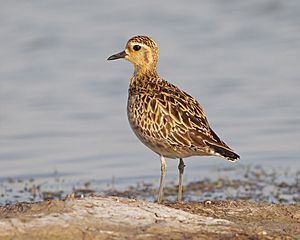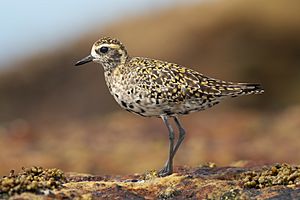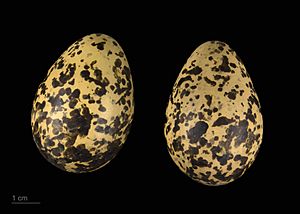Pacific golden plover facts for kids
Quick facts for kids Pacific golden plover |
|
|---|---|
 |
|
| In breeding plumage at Bering Land Bridge National Preserve, Alaska | |
 |
|
| In non-breeding plumage at Laem Pak Bia, Thailand | |
| Conservation status | |
| Scientific classification | |
| Genus: |
Pluvialis
|
| Species: |
fulva
|
 |
|
| Range of P. fulva Breeding Passage Non-breeding Vagrant (seasonality uncertain) | |
| Synonyms | |
|
Charadrius fulvus |
|
The Pacific golden plover (Pluvialis fulva) is a medium-sized plover bird. Its name comes from the Latin word pluvia, meaning "rain." People once thought these birds gathered when rain was coming. The word fulva means "tawny" or yellowish-brown, describing its color.
Contents
What it Looks Like
This plover is about 23 to 26 centimeters (9 to 10 inches) long. When it's time to breed, its feathers are very striking. Its head, back, and wings are spotted with gold and black. Its face and neck are black, with a clear white line around them. It also has a black chest and a dark bottom. Its legs are black too.
In winter, the plover's black feathers disappear. It becomes more yellowish on its face and chest. Its belly turns white.
Comparing Golden Plovers
The Pacific golden plover looks a lot like two other golden plovers. These are the European golden plover and the American golden plover. The Pacific golden plover is usually smaller and thinner. It also has longer legs than the European golden plover. The European one has white feathers under its wings.
The Pacific golden plover is very similar to the American golden plover. They were once thought to be the same species. However, the Pacific plover is thinner. It also has shorter wing tips and longer legs. It often has more yellow on its back.
Where it Lives and What it Eats
This bird is a wader, meaning it walks in shallow water or wet ground to find food. It looks for food on open areas like tundra, fields, and beaches. It also searches in muddy areas where the tide goes out. It usually finds its food by sight.
The Pacific golden plover eats mostly insects and small crustaceans. It also enjoys eating some berries.
Breeding Areas
Pacific golden plovers breed in the cold Arctic tundra. This area stretches from northern Eurosiberia all the way to western Alaska. They build their nests on the ground. They choose dry, open spots for their nests.
Amazing Journeys: Migration
These birds are migratory. This means they travel very long distances between their breeding and winter homes. They spend their winters in warmer places like south Asia and Australia. A few of them also winter in California and Hawaii in the USA.
In Hawaii, this bird is called the kōlea. In New Zealand, the Māori people call it kuriri. It is very rare to see this bird in western Europe.
Long-Distance Flights
Scientists have learned amazing things about their travels. These birds return to the same wintering spots every year. This allowed researchers in Hawaii to attach tiny tracking devices to them. They could then find the birds again the next year in the same place. This research showed that these plovers fly about 4,800 kilometers (3,000 miles) without stopping. They make this incredible journey from Alaska to Hawaii in just 3 to 4 days!
- Pluvialis fulva in Field Guide: Birds of the World on Flickr
See also
 In Spanish: Chorlito dorado asiático para niños
In Spanish: Chorlito dorado asiático para niños




